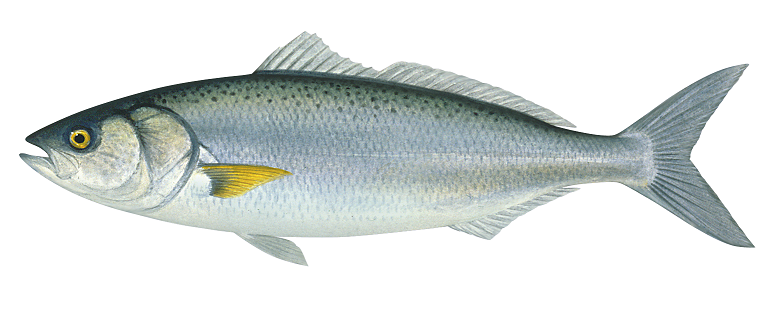Eastern Australian Salmon
pinungana (Fish)
In palawa kani, the language of Tasmanian Aborigines, with thanks to the Tasmanian Aboriginal Centre.
Arripis trutta (Eastern Australian Salmon)

2022/23 Eastern Australian Salmon Status (Released August 24)
| Stock Status | SUSTAINABLE | ||
| Summary | Eastern Australian Salmon has a long history of exploitation across south-eastern Australia. The recent low commercial landings in Tasmania are probably due to market demand rather than a decrease in abundance. The current fishing pressure in Tasmania is significantly lower than the historically sustained levels and is therefore unlikely to impair the recruitment of the biological stock | ||
| Importance | Key | ||
| Stock | Tasmanian Scalefish Fishery | ||
| Indicator(s) | Catch, effort and CPUE trends | ||
| Managing Jurisdiction | State (Tasmania) | ||
Background
There are two species of Australian Salmon inhabiting Tasmanian waters: Arripis trutta (Eastern Australian Salmon) and Arripis truttaceus (Western Australian Salmon). Eastern Australian Salmon constitutes approximately 94% of Tasmanian commercial catches (Krueck et al. 2020). Eastern Australian Salmon is a schooling species, mainly caught by Tasmanian commercial fishers in inshore waters using beach seine, as well as some gillnet and purse seine gear. Eastern Australian Salmon constitute a single well-mixed stock in southeast Australian waters, traveling great distances among states (Queensland, New South Wales, Victoria, and Tasmania) (Stewart et al. 2011). Juveniles (4 – 6 cm fork length) appear in shallow Tasmanian waters between January and September (Kailola et al. 1993). The Tasmanian Scalefish Fishery predominantly catches subadults.
Australian Salmon have a long history of exploitation in Tasmania, with large-scale commercial fishing occurring since at least 1958 (Stewart et al. 2011). There are two distinct sectors in the commercial fishery: (1) a small number of large vessels specifically equipped to capture and store large quantities of Australian Salmon, and (2) a large number of small vessels that target the species on an opportunistic basis or take them as by-product. Changes in market demand and prices for Australian Salmon have largely driven changes in catch over time, with fishers participating in other fisheries when Australian Salmon is less economically viable. Australian Salmon is the second most important species for recreational fishers (Lyle 2005, Lyle et al. 2009, Lyle et al. 2014, Lyle et al. 2019), who target this species mainly by using line fishing methods.
The latest full Scalefish Assessment can be found at the link:
Learn more about what each stock status classification means on our Stock Status Classifications Information Page:




Social and Economic Indicators